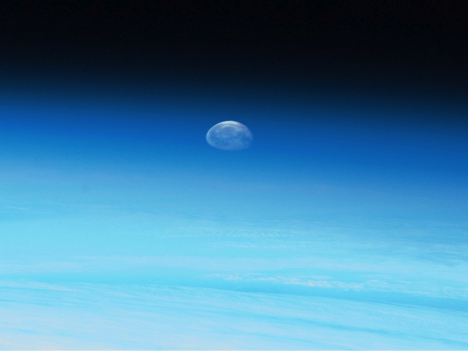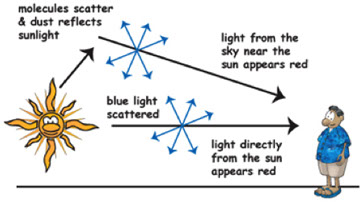-
WHAT IS NASA PHYSICS?
-
MODULES
-
Forces and Motion
-
Conservation of Momentum & Energy
-
Temperature and Heat
-
Fluids
-
Optics
-
Electromagnetic Spectrum
-
Modern Physics
-
Anticipation Guide 7
-
Intro to Modern Physics
-
Blackbody Radiation
-
The Ultraviolet Catastrophe
-
The Photoelectric Effect
-
Bohr's Atom
-
Spectra
-
Radioactive Decay
-
Special Relativity (SR)
-
Simultaneity
-
Distance and Time
-
General Relativity
-
May the Forces be with You
-
Modern Physics Notebook
-
Assessment Problems 7
-
-
Useful Things
-
-
SITE MAP
Optics
Equation
n = c/v
5.2
Equation
sin i———sin r=v1———v2= n2———n1
5.3
The best site for rainbows and other optical marvels in air.
Refraction
When light passes through one transparent material into a different type, the light bends – refracts – toward or away from the direction it was traveling. After this bend, light will travel in a straight line until it exits this material and enters another. The light bends because it travels at different speeds through different materials (e.g., air, water, glass, alcohol); it only travels at the speed of light when passing through a vacuum (but goes almost that fast through air). Note that bending occurs only if the light strikes the material at an angle so that one part of a wave gets slowed down before other parts do. If light strikes a material head on there is no bending, right?
Light traveling through the vacuum of space has a refractive index, n, of 1, where the refractive index (or index of refraction) of any other transparent material is the ratio of the speed on light in space, c, to the speed in the material, v. The speed in a material is always less than the speed in a vacuum. The refractive index, n, is:
Refractive index = the speed on light in a vacuum / speed of light in a substance
n = c/v
The value of n is always larger than 1.0; the higher the n the slower the light.
 While the vacuum of space and air have the refractive index 1.00, most transparent liquids and solids, including water and ice, have refractive indices above 1.3. Ice at 1.31 has a slightly lower refractive index than water at 1.33. Cubic zirconium – a low cost diamond substitute - has a high refractive index of about 2.2, while real diamond is 2.4. If you aren’t sure whether your diamond is real, measure its n!
While the vacuum of space and air have the refractive index 1.00, most transparent liquids and solids, including water and ice, have refractive indices above 1.3. Ice at 1.31 has a slightly lower refractive index than water at 1.33. Cubic zirconium – a low cost diamond substitute - has a high refractive index of about 2.2, while real diamond is 2.4. If you aren’t sure whether your diamond is real, measure its n!
To calculate exactly where a refracted ray will go when passing from one material into, use Snell’s Law. This takes into account the differing speed of light in different materials to calculate the amount of bending.
 Ratio of the sines of incident to refracted angles= ratio of velocities in incident to refractive materials= ratios of index of refraction in second to first materials
Ratio of the sines of incident to refracted angles= ratio of velocities in incident to refractive materials= ratios of index of refraction in second to first materials
sin i———sin r=v1———v2= n2———n1
Snell’s Law showing bending of a ray of light passing from one material, 1, into a second, 2. Diagram modified from Wikipedia.
Refraction + Raindrops = Rainbows
Isaac Newton discovered that white light is actually a mixture of light of different wavelengths. Each wavelength of light has a different color and frequency, where frequency is how rapidly the wave moves up and down. The longer the wavelength, the slower the wave travels. So different wavelengths of light bend at different angles when passing into a prism – that is why a prism separates incoming white light into its component colors.
Raindrop; Image modified from Wikipedia
 White LightRedOrangeYellowGreenBlueVioletPrisms are not the only things that can break light into its colors. Even though they are spherical, raindrops act like prisms. Raindrops both refract and reflect light, producing rainbows. Sunlight is refracted when passing from air into the water drop, and then it reflects off the curved backside of the drop, and refracts again when moving back into air. Rainbows occur on the opposite side of the sky from where the Sun is, and there must be raindrops to produce the bow. A wonderful thing about rainbows is each is centered on you the observer.
White LightRedOrangeYellowGreenBlueVioletPrisms are not the only things that can break light into its colors. Even though they are spherical, raindrops act like prisms. Raindrops both refract and reflect light, producing rainbows. Sunlight is refracted when passing from air into the water drop, and then it reflects off the curved backside of the drop, and refracts again when moving back into air. Rainbows occur on the opposite side of the sky from where the Sun is, and there must be raindrops to produce the bow. A wonderful thing about rainbows is each is centered on you the observer.  The photographer’s shadow at the bottom of the rainbow photo is the center of this rainbow. If the photographer moves over 50 m there will be another rainbow centered on him/her. Next time you see a rainbow, enjoy your personal rainbow, no one else sees exactly the same one.
The photographer’s shadow at the bottom of the rainbow photo is the center of this rainbow. If the photographer moves over 50 m there will be another rainbow centered on him/her. Next time you see a rainbow, enjoy your personal rainbow, no one else sees exactly the same one.
Left: Rainbow; Image from Wikipedia
Refraction Causes Red Sunsets and Flattened Suns
 Flattened Moon seen from the International Space Station. Differential refraction of moonlight by a long passage through Earth’s atmosphere flattens bottom of Moon more than top. NASA image.Because light travels slightly slower through air than through the vacuum of space, there is some bending/refraction of the Sun’s rays at the point where space meeting atmosphere. This refracted light causes the Sun to appear higher in the ski than it is. This causes the Sun to be visible AFTER it has set because refraction bends the Sun’s rays upward. So daylight actually is slightly prolonged because of the upward refraction of sunlight. This also happens at sunrise but few students ever see it.
Flattened Moon seen from the International Space Station. Differential refraction of moonlight by a long passage through Earth’s atmosphere flattens bottom of Moon more than top. NASA image.Because light travels slightly slower through air than through the vacuum of space, there is some bending/refraction of the Sun’s rays at the point where space meeting atmosphere. This refracted light causes the Sun to appear higher in the ski than it is. This causes the Sun to be visible AFTER it has set because refraction bends the Sun’s rays upward. So daylight actually is slightly prolonged because of the upward refraction of sunlight. This also happens at sunrise but few students ever see it.
If there is a distant horizon (e.g., across a large plain or body of water), there is a difference in the amount of light bending from the top to the bottom of the Sun, with the Sun appearing squashed. This happens to the Moon too. To find something else odd that happens when the sunset is on a distant horizon google the green flash, which is not an action hero!
Refraction Causes Mirages Too
 Not a lake but a mirage on the Nevada desert. Image from Wikipedia.Refraction never stops producing amazing things. Because light travels slightly faster through hot air than through cooler air, rays of light bend up from a hot road or from a desert floor. To a driver on the hot road or looking across the desert, there appears to be reflecting light, so the surface appears to be wet. The phenomenon produces mirages. You’ve probably seen mirages on the highway and now you know that hot air and refracting light cause them. Amaze your friends who don’t take physics.
Not a lake but a mirage on the Nevada desert. Image from Wikipedia.Refraction never stops producing amazing things. Because light travels slightly faster through hot air than through cooler air, rays of light bend up from a hot road or from a desert floor. To a driver on the hot road or looking across the desert, there appears to be reflecting light, so the surface appears to be wet. The phenomenon produces mirages. You’ve probably seen mirages on the highway and now you know that hot air and refracting light cause them. Amaze your friends who don’t take physics.
Blue Sky, Red Sunset

 When light waves encounter particles smaller than the wavelength of light, the light waves are absorbed by the particles, which then re-emit light in all directions – this is called scattering. Our atmosphere is largely composed of molecules of oxygen and nitrogen, which are smaller than the wavelengths of high frequency light. Violet and blue light are the highest frequency and shortest wavelength of visible light colors and thus are scattered across the sky, making it a blue color. Why isn’t the sky violet? It is, but we don’t see it because our eyes are much more sensitive to blue than to violet. Think of all the songs and poems that would have to be rewritten if we saw violet better: Violet skies, smiling at me, nothing but violet skies do I see.
When light waves encounter particles smaller than the wavelength of light, the light waves are absorbed by the particles, which then re-emit light in all directions – this is called scattering. Our atmosphere is largely composed of molecules of oxygen and nitrogen, which are smaller than the wavelengths of high frequency light. Violet and blue light are the highest frequency and shortest wavelength of visible light colors and thus are scattered across the sky, making it a blue color. Why isn’t the sky violet? It is, but we don’t see it because our eyes are much more sensitive to blue than to violet. Think of all the songs and poems that would have to be rewritten if we saw violet better: Violet skies, smiling at me, nothing but violet skies do I see.
 The lower frequency light that isn’t scattered as much continues straight down through the atmosphere, and that is what we see when looking directly toward the Sun. The Sun’s output is greatest in the yellow portion of the spectrum and yellow is little scattered so the Sun looks yellow to us. Do you think it is a coincidence that our eyes evolved over millions of years to be most sensitive to the wavelength where our Sun is brightest?
The lower frequency light that isn’t scattered as much continues straight down through the atmosphere, and that is what we see when looking directly toward the Sun. The Sun’s output is greatest in the yellow portion of the spectrum and yellow is little scattered so the Sun looks yellow to us. Do you think it is a coincidence that our eyes evolved over millions of years to be most sensitive to the wavelength where our Sun is brightest?
 From noon to sunset as the Sun moves from high in our sky towards the western horizon, its light passes through more and more particles – such as dust, pollution and even volcanic ash – that are bigger than oxygen and nitrogen and scatter more strongly at the red end of the spectrum. So near sunsets and sunrises, for those who are awake at that time of day, the sky is yellow, pink and sometimes red. In fact, powerful volcanic eruptions that send millions of tons of tiny ash particles into the sky sometimes create sunsets that look like the sky is on fire.
From noon to sunset as the Sun moves from high in our sky towards the western horizon, its light passes through more and more particles – such as dust, pollution and even volcanic ash – that are bigger than oxygen and nitrogen and scatter more strongly at the red end of the spectrum. So near sunsets and sunrises, for those who are awake at that time of day, the sky is yellow, pink and sometimes red. In fact, powerful volcanic eruptions that send millions of tons of tiny ash particles into the sky sometimes create sunsets that look like the sky is on fire.
Images from NASA, Spaceplace
Images from NASA, Spaceplace
© 2013 by Wheeling Jesuit University/Center for Educational Technologies®. 316 Washington Ave., Wheeling, WV 26003-6243. All rights reserved. Privacy Policy and Terms of Use.

